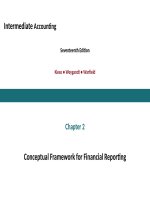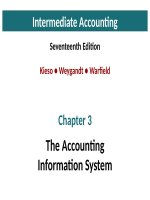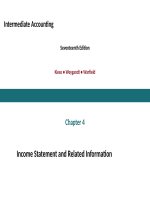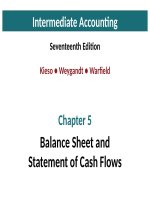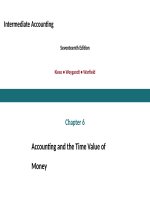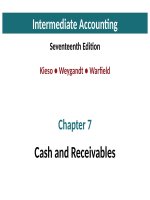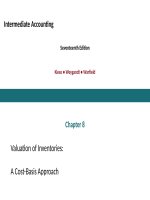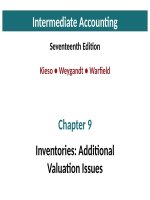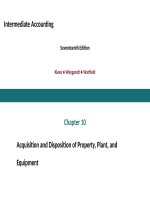Intermediate accounting 17e by kieso ch16
Bạn đang xem bản rút gọn của tài liệu. Xem và tải ngay bản đầy đủ của tài liệu tại đây (1.57 MB, 120 trang )
Intermediate Accounting
Seventeenth Edition
Kieso ● Weygandt ● Warfield
Chapter 16
Dilutive Securities and Earnings per Share
This slide deck contains animations. Please disable animations if they cause issues with your device.
Learning Objectives
After studying this chapter, you should be able to:
1.
Describe the accounting for the issuance, conversion, and retirement of convertible securities.
2.
Contrast the accounting for stock warrants and for stock warrants issued with other securities.
3.
Describe the accounting and reporting for stock compensation plans.
4.
Compute basic earnings per share.
5.
Compute diluted earnings per share.
Copyright ©2019 John Wiley & Sons, Inc.
2
Preview of Chapter 16
Dilutive Securities and Earnings Per Share
Dilutive Securities
•
Debt and equity
•
Convertible debt
•
Convertible preferred stock
Stock Warrants
•
Warrants and other securities
•
Stock rights
Copyright ©2019 John Wiley & Sons, Inc.
3
Preview of Chapter 16
Stock Compensation Plans
•
Measurement
•
Recognition
•
Restricted stock
•
Employee stock-purchase plans
•
Disclosure of compensation plans
Basic Earnings Per Share
•
Simple structure
•
Comprehensive example
Copyright ©2019 John Wiley & Sons, Inc.
4
Preview of Chapter 16
Diluted Earnings Per Share
•
Convertible securities
•
Options and warrants
•
Contingent issues
•
Antidilution
•
Presentation and disclosure
Copyright ©2019 John Wiley & Sons, Inc.
5
Learning Objective 1
Describe the Accounting for the Issuance, Conversion, and
Retirement of Convertible Securities
LO 1
Copyright ©2019 John Wiley & Sons, Inc.
6
Dilutive Securities
Debt and Equity
Should companies report these financial instruments as a liability or equity.
Stock Options
LO 1
Convertible Securities
Copyright ©2019 John Wiley & Sons, Inc.
Preferred Stock
7
Dilutive Securities
Accounting for Convertible Debt
Convertible bonds can be changed into other corporate securities during some specified period of
time after issuance.
LO 1
Copyright ©2019 John Wiley & Sons, Inc.
8
Accounting for Convertible Debt
Two main reasons corporations issue convertibles:
1.
To raise equity capital without giving up more ownership control than necessary.
2.
Obtain debt financing at cheaper rates.
The accounting for convertible debt involves reporting issues at the time of (1) issuance, (2)
conversion, and (3) retirement.
LO 1
Copyright ©2019 John Wiley & Sons, Inc.
9
Accounting for Convertible Debt
At Time of Issuance
Recording convertible bonds follows the method used to record straight debt issues, with any
discount or premium amortized over the term of the debt.
Global View
IFRS requires that the issuer of convertible debt record the liability and equity components
separately.
LO 1
Copyright ©2019 John Wiley & Sons, Inc.
10
Accounting for Convertible Debt
At Time of Conversion
Companies use the book value method when converting bonds.
When the debtholder converts the debt to equity, the issuing company recognizes no gain or loss
upon conversion.
LO 1
Copyright ©2019 John Wiley & Sons, Inc.
11
At Time of Conversion
Illustration
Hilton, Inc. has a $1,000 bond that is convertible into 10 shares of common stock (par value $10). At the time
of conversion, the unamortized premium is $50. Hilton records the conversion of the bonds as follows.
Bonds Payable
1,000
Premium on Bonds Payable
LO 1
50
Common Stock
100
Paid-in Capital in Excess of Par—Common
950
Copyright ©2019 John Wiley & Sons, Inc.
12
Accounting for Convertible Debt
Induced Conversion
LO 1
•
Issuer wishes to encourage prompt conversion.
•
Issuer offers additional consideration, called a “sweetener.”
•
Sweetener is an expense of the current period.
Copyright ©2019 John Wiley & Sons, Inc.
13
Induced Conversion
Illustration: Helloid, Inc. has outstanding $1,000,000 par value convertible debentures convertible into 100,000 shares
of $1 par value common stock. Helloid wishes to reduce its annual interest cost. To do so, Helloid agrees to pay the
holders of its convertible debentures an additional $80,000 if they will convert. Assuming conversion occurs, Helloid
makes the following entry.
Debt Conversion Expense
80,000
Bonds Payable
1,000,000
Common Stock (100,000 x $1)
100,000
Paid-in Capital in Excess of Par—Common
900,000
Cash
LO 1
80,000
Copyright ©2019 John Wiley & Sons, Inc.
14
Accounting for Convertible Debt
Retirement of Convertible Debt
•
Recognized same as retiring debt that is not convertible.
•
Difference between the cash acquisition price and carrying amount should be reported as
gain or loss in the income statement.
LO 1
Copyright ©2019 John Wiley & Sons, Inc.
15
Dilutive Securities
Convertible Preferred Stock
Convertible preferred stock includes an option for the holder to convert preferred shares into a
fixed number of common shares.
LO 1
•
Classified as part of stockholders’ equity, unless mandatory redemption exists.
•
No theoretical justification for recognizing a gain or loss when exercised.
•
Company uses the book value method.
Copyright ©2019 John Wiley & Sons, Inc.
16
Convertible Preferred Stock
Illustration: Host Enterprises issued 1,000 shares of common stock (par value $2) upon conversion of 1,000
shares of preferred stock (par value $1) that was originally issued for a $200 premium. The entry would be:
Convertible Preferred Stock (1,000 × $1)
1,000
Paid-in Capital in Excess of Par—Preferred
200
Retained Earnings
800
Common Stock (1,000 x $2)
LO 1
2,000
Copyright ©2019 John Wiley & Sons, Inc.
17
Learning Objective 2
Contrast the Accounting for Stock Warrants and for Stock Warrants
Issued with Other Securities
LO 2
Copyright ©2019 John Wiley & Sons, Inc.
18
Stock Warrants
Warrants are certificates entitling the holder to acquire shares of stock at a certain price within a
stated period.
Normally arises under three situations:
1.
To make the security more attractive.
2.
Existing stockholders have a preemptive right to purchase common stock first.
3.
To executives and employees as a form of compensation.
LO 2
Copyright ©2019 John Wiley & Sons, Inc.
19
Stock Warrants
Stock Warrants Issued with Other Securities
Basically long-term options to buy common stock at a fixed price.
LO 2
•
Generally life of warrants is five years, occasionally ten years.
•
Proceeds allocated between the two securities.
•
Allocation based on fair market values.
•
Two methods of allocation:
1)
proportional method
2)
incremental method
Copyright ©2019 John Wiley & Sons, Inc.
20
Stock Warrants
Proportional Method
Determine:
1.
value of the bonds without the warrants, and
2.
value of the warrants.
The proportional method allocates the proceeds using the proportion of the two amounts, based on
fair values.
LO 2
Copyright ©2019 John Wiley & Sons, Inc.
21
Proportional Method
Illustration: Assume that AT&T’s bonds (par $1,000) sold for 99 without the warrants soon after their issue.
The market price of the warrants at that time was $30. (Prior to sale the warrants will not have a fair value.)
The allocation relies on an estimate of fair value, generally as established by an investment banker, or on the
relative fair value of the bonds and the warrants soon after the company issues and trades them. The price
paid for 10,000, $1,000 bonds with the warrants attached was par, or $10,000,000. The following illustration
shows the proportional allocation of the bond proceeds between the bonds and warrants.
LO 2
Copyright ©2019 John Wiley & Sons, Inc.
22
Proportional Method
Allocation of Proceeds between Bonds and Warrants
LO 2
Copyright ©2019 John Wiley & Sons, Inc.
23
Proportional Method
Allocation of Proceeds between Bonds and Warrants
The bonds sell at a discount. AT&T records the sale as follows.
Cash
9,705,882
Discount on Bonds Payable
294,118
Bonds Payable
10,000,000
In addition, AT&T sells warrants that it credits to paid-in capital. It makes the following entry.
Cash
294,118
Paid-in Capital—Stock Warrants
LO 2
294,118
Copyright ©2019 John Wiley & Sons, Inc.
24
Proportional Method
Investors Exercise all 1,000 Warrants
Assuming investors exercise all 10,000 warrants (one warrant per one share of stock), AT&T makes the
following entry.
Cash (10,000 x $25)
250,000
Paid-in Capital—Stock Warrants
294,118
Common Stock (10,000 × $5)
50,000
Paid-in Capital in Excess of Par—Common
494,118
What if investors fail to exercise the warrants, AT&T debits Paid-in Capital—Stock Warrants for $294,118 and
credits Paid-in Capital—Expired Stock Warrants for a like amount.
LO 2
Copyright ©2019 John Wiley & Sons, Inc.
25
